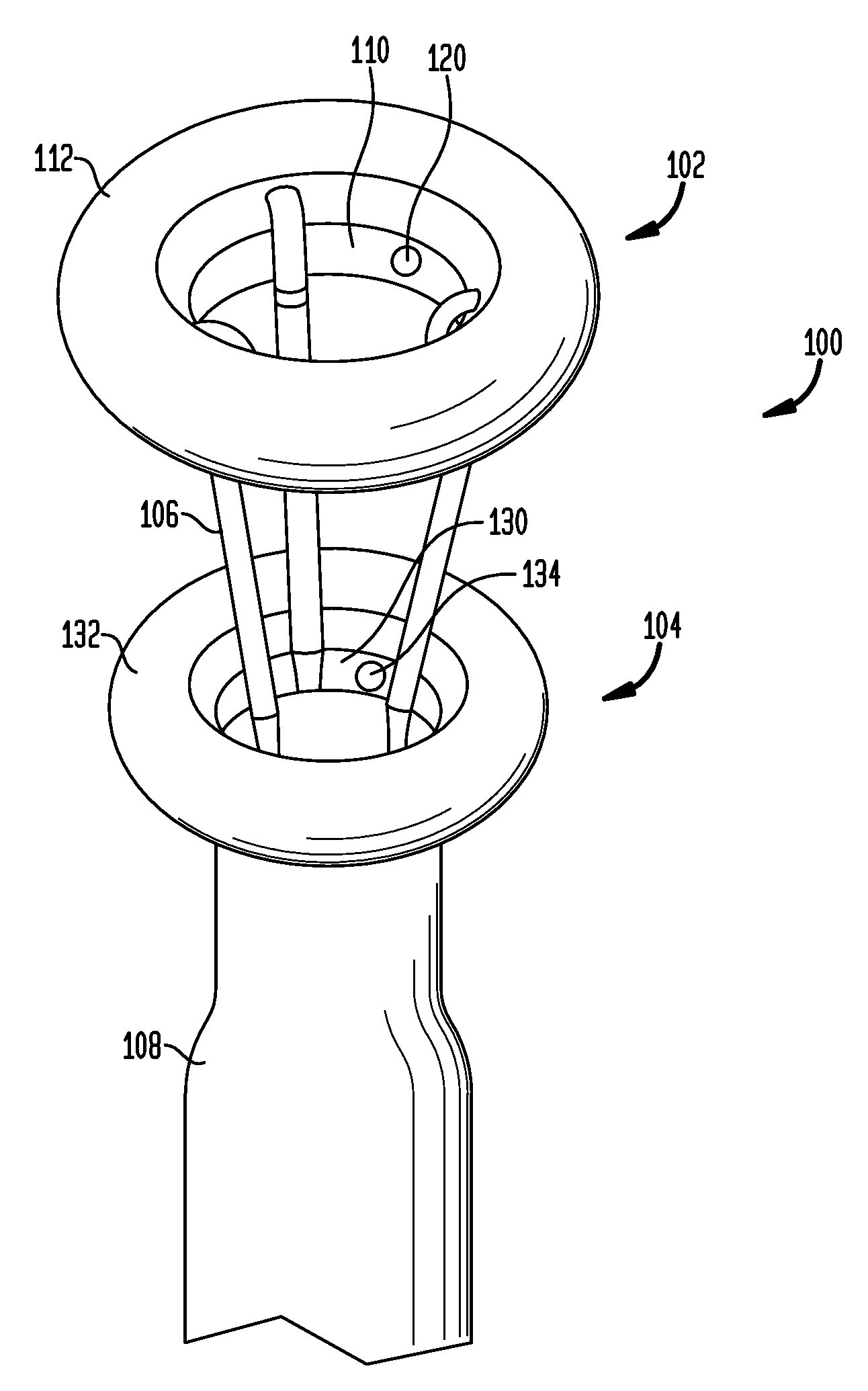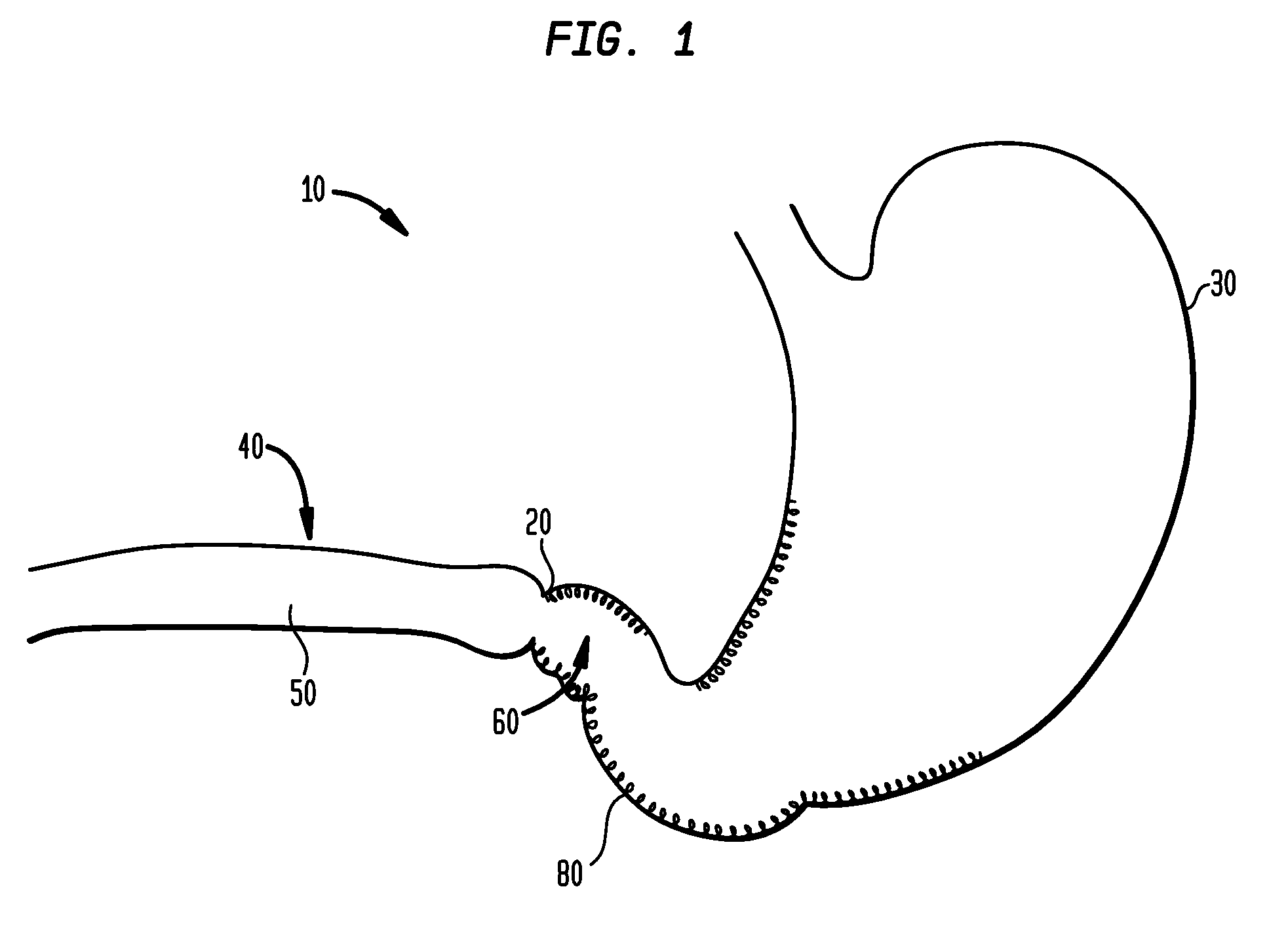[0013]A key
advantage of the present invention is that the obesity device can be placed and removed endoscopically through the patient's
esophagus in a minimally invasive
outpatient procedure. In addition, the obesity device expands to fit securely against tissue within the GI tract such that the position of the device is substantially maintained throughout the digestive process. Thus, the device is “self-anchoring” and does not require invasive tissue fixation within the patient's GI tract, thereby reducing collateral
tissue damage and minimizing its
impact on the digestive process. Also, unlike other more invasive procedures such as
gastric bypass, the obesity device of the present invention does not require any permanent restructuring of the GI
anatomy. Once the device is removed, the patient's GI tract should being to function normally and in the same manner as if the device were never placed in the patient.
[0014]The flow restrictor is preferably coupled to the anchor by one or more flexible columns that extend through the pyloric
sphincter in the operative position. The flexible columns allow both the flow restrictor and the anchor to move back and forth within the stomach and
duodenum, respectively, with the natural
peristalsis motion of the patient. In the preferred embodiments, the flow restrictor and the anchor will periodically or continuously apply slight
contact pressure to the
distal portion of the pyloric
antrum and the proximal portion of the
duodenum, respectively.
[0015]Another
advantage of the present invention is that the slight
contact pressure placed on the pyloric
antrum and / or duodenum causes an increase in
vagal nerve activity. The pyloric
antrum and duodenum are innervated by the enteric
nervous system and the parasympathetic
nervous system (i.e., the
vagus nerve). Many researchers have shown that the
vagus nerve is responsible for the majority of
afferent signals responsible for satiety. Thus, it is believed that increasing the
afferent vagal nerve activity will result in satiety signals produced by the brain, making the patient feel more full and less inclined to eat. This provides an additional mechanism to treat obesity according to the present invention.
[0016]In a preferred embodiment, the flow restrictor comprises a substantially hollow structure, e.g., a
balloon, defining an exterior wall and an interior. The
balloon includes a fluid inlet, preferably with a one-way valve, for delivering a fluid into the interior of the
balloon to inflate the balloon into the operative configuration after the balloon has been positioned within the patient's stomach. The flow restrictor will preferably have a shape in the inflated position that substantially corresponds to the
anatomy of the distal region of the stomach or pyloric antrum. The exterior wall of the balloon may comprise a number of suitable biocompatible materials, such as
silicone and the like. The fluid is preferably a biocompatible fluid, such as isotonic
saline, that can be safely expelled into the patient's stomach upon removal of the device.
[0017]In one embodiment, the flow restrictor comprises a substantially conical shape. Preferably, the exterior wall of the flow restrictor comprises an outer membrane forming proximal and distal substantially planar surfaces and tapering in the longitudinal direction from the proximal to the distal surface. The distal surface will preferably have an outer
diameter larger than the
maximum diameter of the pyloric
sphincter to prevent distal movement of the flow restrictor into the pyloric
sphincter. In exemplary embodiments, the flow restrictor will further include stiffer components, such as ribs or bosses, extending along the outer membrane to provide support to the structure against the natural
peristalsis forces within the stomach that will act against flow restrictor during operation.
[0018]In another embodiment, the flow restrictor in the inflated configuration comprises a substantially cylindrical central core section and one or more substantially annular flanges or projections that extend radially outward from the central core. In this embodiment, the flanges serve to correspond with the stomach
anatomy. To that end, the proximal
flange preferably has a larger
diameter than the distal
flange(s) and the distal most
flange preferably has a
diameter larger than the
maximum diameter of the pyloric sphincter.
 Login to View More
Login to View More  Login to View More
Login to View More 


